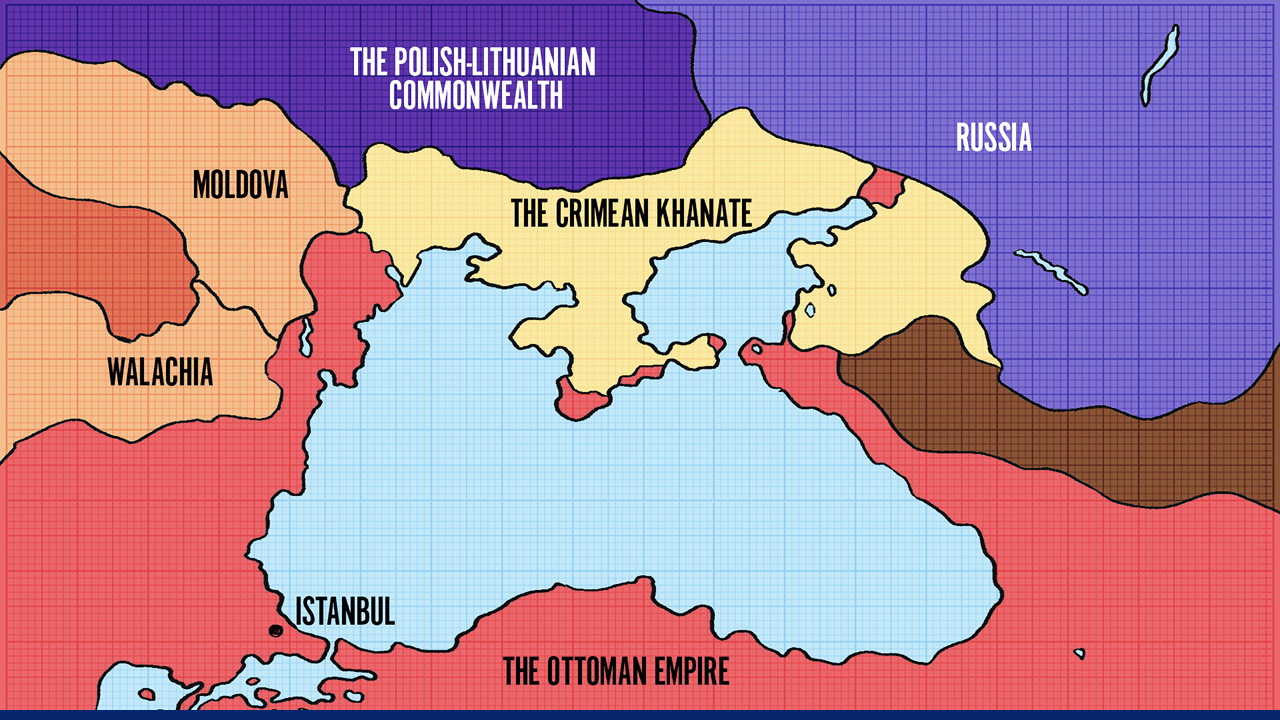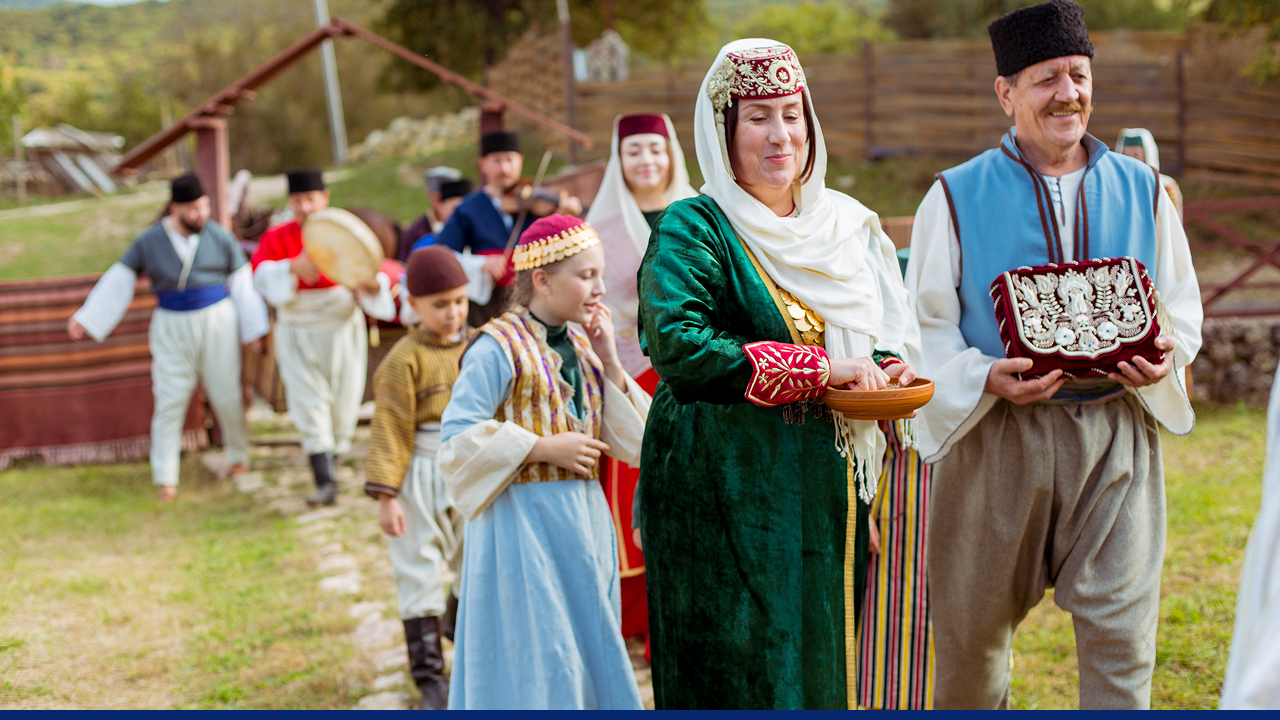14 May 2025
10 MIN READ
Who Are Crimean Tatars?
Summary
The Crimean Tatars have called Crimea home for centuries. Once rulers of their own khanate, they were later exiled by Stalin, and today face renewed pressure under Russian control. Many have fled, others have stayed, holding on to their language, culture, and hope.
While Russia and Ukraine continue to dispute Crimea's origins, the real indigenous people of the peninsula are the Tatars. Who are they? And where do they stand regarding the current war?

May 18th is the 81st anniversary of the mass deportation of Crimea’s Tatars to Central Asia. Source: Iva Zimova/Panos/Redux
Crimean Tatars: The Indigenous People of Crimea Ukraine
Who are the Crimean Tatars?
The Crimean Tatars are a Turkic ethnic group from the Crimean Peninsula, by the Black Sea. Their ancestry stems from Turkic tribes, Mongols of the Golden Horde, and local populations in Crimea after the 13th century.
Rise and fall of the Crimean Khanate
In the 15th century, they established the Crimean Khanate, a powerful Muslim state that became a vassal of the Ottoman Empire. The Khanate was a significant political and military force until 1783, when the Russian Empire annexed Crimea, ending their sovereignty.
Russian rule and displacement
After annexation, Crimean Tatars suffered from land confiscation, marginalization, and mass emigration, particularly to the Ottoman Empire. Under Soviet rule, their situation worsened, culminating in the 1944 deportation of over 200,000 Tatars to Central Asia, primarily Uzbekistan.
They were not allowed to return to Crimea until the late 1980s, when the Soviet Union weakened. Since Ukraine gained independence in 1991, they have tried to rebuild its culture in Crimea. However, after Russia annexed Crimea in 2014, many Crimean Tatars once again reported rising repression, surveillance, and human rights abuses under Russian control.

Crimean Khanate at its height, positioned between powerful neighbors including the Ottoman Empire, Russia, and the Polish–Lithuanian Commonwealth, with its strategic location on the Black Sea. Source: Paradox Forum
From Majority to Minority in Crimea Russia and Crimea Ukraine
Were Crimean Tatars always a minority?
Crimean Tatars were once the majority. They prospered during the Crimean Khanate (15th–18th century), a strong Muslim state under the Ottoman Empire. This changed when the Russian Empire annexed Crimea in 1783.
Russian colonization and demographic change
Russian colonization brought land seizures and persecution, which led to many Tatars emigrating to the Ottoman Empire in the 19th century. By the early 20th century, they had become a minority. In 1944, Stalin ordered a mass deportation that almost wiped them out in Crimea.
Impact of the 1944 deportation
Although some returned in the late 20th century, they remained a minority. Crimean Tatars comprise around 12–15% of Crimea’s population (pre-2014). Their numbers and influence are limited by historical displacement and current political pressures.
A History of Trauma and Exile: Crimean Tatars in Soviet Crimea
The mass deportation of Crimean Tatars (1944)
Joseph Stalin ordered the mass deportation of Crimean Tatars to take place on May 18, 1944. The Tatars were accused of collaborating with Nazi Germany during World War II, which was never proven. Nearly the entire Crimean Tatar population, around 230,000 people, was forcibly removed from Crimea in a matter of days. Soviet forces rounded up families and loaded them onto overcrowded, unsanitary freight trains bound for remote parts of Central Asia, mainly Uzbekistan.
Deportation and death
The journey lasted for several weeks, during which thousands died from starvation, disease, or exhaustion. The deportees faced harsh conditions upon arrival, with forced labor and discrimination. Many didn’t survive long after their arrival; around 46% of the Crimean Tatars deported between 1942 and 1947 died.
Erasure of identity
In addition to the deportations, many of the Soviets tried to erase Crimean Tatar history by closing schools, banning their language, and renaming Crimean towns and landmarks. The Soviets transferred ethnic Russians and Ukrainians to repopulate Crimea, while Crimean Tatars were forbidden to return for decades.
Return to Crimea Ukraine
It wasn’t until the late 1980s, during the final years of the Soviet Union under Mikhail Gorbachev, that Crimean Tatars began returning to their ancestral homeland. Though permitted to return, returnees received little state assistance and faced housing and land shortages.
The 1944 deportation remains a profoundly traumatic event for the community and is observed every year as a symbol of survival, loss, and resistance. May 18 is marked as a day of remembrance and mourning for the victims of the 1944 deportation.
Rebuilding in Crimea Ukraine: Crimean Tatars After 1991
What is the status of Crimean Tatars in Ukraine?
In Ukraine, Crimean Tatars are seen as an indigenous group with unique cultural and political rights. Since Ukraine gained independence in 1991, the government has supported its return to Crimea. It has also backed efforts to restore their language, traditions, and historical justice. The Mejlis, their representative body, has been vital in advocating for their interests.
Challenges despite support
While Ukraine has made efforts to support the Crimean Tatar community, many challenges remain, mainly on an institutional level. These include difficulties related to housing, political representation, and unresolved legal claims. Crimean Tatars have often been underrepresented in the government and faced social exclusion in parts of Crimea. Some have reported being victims of Islamophobia.
At the same time, some argue that Russia weaponizes these stories against Ukraine, despite Islamaphobia being a problem in many other countries, including parts of Russia.
Post-2014 migration and recognition
After Russia annexed Crimea in 2014, tens of thousands of Crimean Tatars fled to mainland Ukraine. The Ukrainian government increased its support by offering Crimean Tatar language education and limited legal protection. Some Tatars, however, see this support as symbolic rather than systemic.
Legal recognition
In 2021, Ukraine passed a law recognizing Crimean Tatars as an indigenous people, affirming their right to self-determination within Ukraine, and condemning Russia’s actions in occupied Crimea.

Crimean Tatars dressed for a wedding in traditional dress from the 19th century. Source: Beyé Shevkiyeva/Wikimedia Commons
Crimean Tatars Under Crimea Russia's Rule
How did their lives change after Russia annexed Crimea in 2014?
Since Russia’s 2014 annexation of Crimea, the lives of the Tatars have been interrupted again. Initially, they were hoping Ukraine, with international support, would reclaim control. However, as time passed, many are struggling to find optimism. About 20,000 left for mainland Ukraine, fearing repression and religious limits under Russian rule.
Adapting and resisting
By 2017-2019, the hopes started to fade, so many Tatars developed survival strategies, recalling earlier exile experiences from Central Asia after Soviet deportations in 1944. Some adapted, taking advantage of Russian opportunities, while quietly resisting through cultural preservation and family bonds. Others embraced duality: outward conformity with inner dissent.
Impact of the 2022 war
The 2022 full-scale Russian war brought back renewed hopes for liberation. However, fears of conscription drove 10,000 Tatars, primarily young men, to flee abroad. This wave of migration further fragments the Tatar community remaining in Crimea.
Like past migrations, this scattering threatens the culture and complicates future returns. Even staying in Crimea today is a quiet act of resistance.
The Crimean Tatar Population in Ukraine Today
How big is the Crimean Tatar community in Ukraine?
Recent estimates put the Crimean Tatar community in Ukraine at around 300,000 to 350,000 people. Before Russia annexed Crimea in 2014, most Crimean Tatars lived on the Crimean Peninsula. Since then, tens of thousands have relocated to mainland Ukraine due to political persecution, threats, or in search of better opportunities.
Mainland strongholds and activism
The largest Crimean Tatar populations in the rest of Ukraine are Kyiv, Kherson, Zaporizhzhia, and Lviv. The community works in exile to preserve its language, culture, and political voice. Despite being displaced, Crimean Tatars are an essential part of Ukrainian society. They advocate for Crimea’s de-occupation and work to defend minority rights for other marginalized groups in Ukraine, such as Roma.
The Global Crimean Tatar Diaspora
Where do Crimean Tatars live outside of Russia and Ukraine?
The Crimean Tatar diaspora populations exist in:
-
Turkey: Estimates vary widely, from 150,000 to over 6 million, depending on whether it includes descendants of earlier migrations from Crimea (mostly during the 18th and 19th centuries under Russian rule).
-
Ukraine and Uzbekistan: The largest populations of Crimean Tatars reside here, with estimates ranging between 200,000 and 300,000
-
Romania: Hosts a Tatar minority estimated at 20,000-30,000, mainly concentrated in the Dobruja region.
-
Russia: Around 2,000-3,000 Crimean Tatars currently reside in the Russian Federation, excluding the population in occupied Crimea.
-
Bulgaria and Kazakhstan: Smaller diaspora communities, estimated between 1,000 and 2,000 people.

Estimated population and geographic distribution of Crimean Tatars around the world. Source: Wikimedia Commons
Looking Ahead: Resilience and Revival in Crimea Ukraine and Beyond
What does the future hold for the Crimean Tatars?
The future of the Crimean Tatars depends on what happens in the Ukraine-Russia conflict. As long as Russia controls Crimea, it risks political repression, cultural suppression, and human rights violations. Many cannot return home safely, and those who stay in Crimea live under threats.
Resilience in exile
Still, the community resists being erased. In mainland Ukraine, Crimean Tatars are rebuilding their institutions. They promote their language and culture, advocate internationally for Crimea's return, and restore their rights. Ukraine's recognition of them as indigenous people has improved their legal and political status. The war has motivated Ukraine to be more proactive in its inclusion.
The path forward
While symbolic progress has been made, true justice and restoration depend on political developments. In either outcome, Russia and Ukraine both bear responsibility for ensuring the rights and well-being of the Crimean Tatar people.
Conclusion
The Crimean Tatars have been part of the peninsula’s story for as long as anyone can remember. They built their own khanate, survived empires, and lived through one of the 20th century’s cruelest deportations. Even now, with war at their doorstep and pressure from all sides, many still hold on to their land, their language, and each other.
It’s easy to reduce Crimea to a political headline. But for the Tatars, it’s home. And in all the noise about borders and power, we can’t afford to forget the people who were there first, and who are still fighting, quietly, not to disappear.
People also ask
What race are Crimean Tatars?
Crimean Tatars are a Turkic ethnic group with a mixed heritage rooted in Central Asian, Mongol, and indigenous Crimean populations.
Who are the Tatars genetically closest to?
Crimean Tatars share the closest genetic ties with other Turkic-speaking populations, particularly Volga Tatars, Bashkirs, Kazakhs, and some Balkan and Caucasus populations. Their gene pool reflects a combination of Central Asian, Eastern European, and Middle Eastern ancestry.
Are Crimean Tatars Muslims?
Yes, the vast majority of Crimean Tatars are Sunni Muslims of the Hanafi school, which is the most widely followed school of Islamic jurisprudence in Central Asia and Turkey. Islam has been central to their identity since the establishment of the Crimean Khanate in the 15th century.
Who are the Tatars descended from?
Crimean Tatars descend from a combination of:
-
Turkic tribes, including Kipchaks and Cumans
-
Mongol warriors and settlers from the Golden Horde
-
Indigenous peoples of the Crimean Peninsula (e.g., Scythians, Goths, Greeks, and others)
Do Tatars eat pork?
Traditionally, observant Crimean Tatars do not eat pork, under Islamic dietary laws. However, secular or less religious Tatars, especially in diaspora communities or among those with Christian or mixed heritage, may consume it. Traditional Tatar cuisine avoids pork and emphasizes lamb, beef, and poultry.
